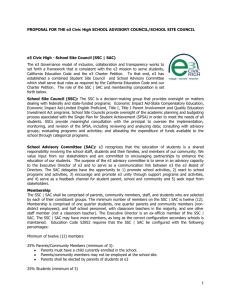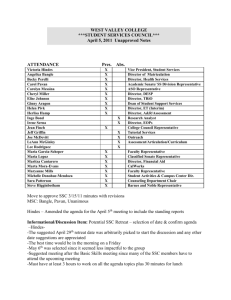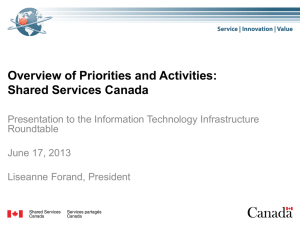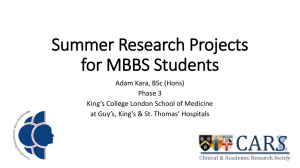IDGEC SSC First Meeting
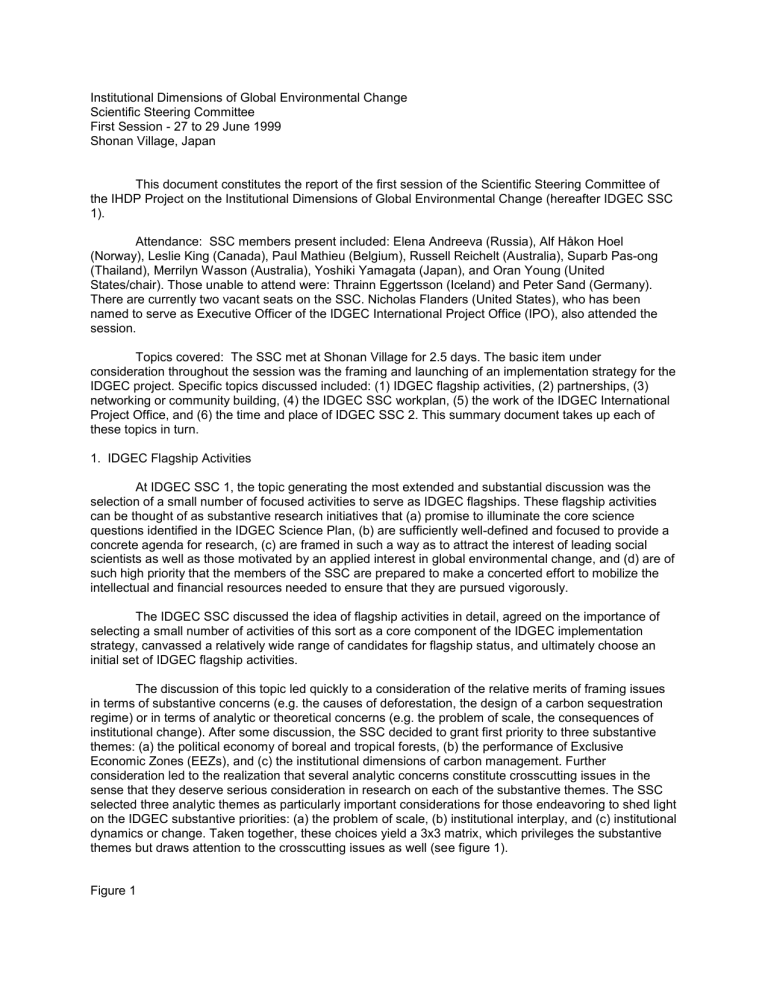
Institutional Dimensions of Global Environmental Change
Scientific Steering Committee
First Session - 27 to 29 June 1999
Shonan Village, Japan
This document constitutes the report of the first session of the Scientific Steering Committee of the IHDP Project on the Institutional Dimensions of Global Environmental Change (hereafter IDGEC SSC
1).
Attendance: SSC members present included: Elena Andreeva (Russia), Alf Håkon Hoel
(Norway), Leslie King (Canada), Paul Mathieu (Belgium), Russell Reichelt (Australia), Suparb Pas-ong
(Thailand), Merrilyn Wasson (Australia), Yoshiki Yamagata (Japan), and Oran Young (United
States/chair). Those unable to attend were: Thrainn Eggertsson (Iceland) and Peter Sand (Germany).
There are currently two vacant seats on the SSC. Nicholas Flanders (United States), who has been named to serve as Executive Officer of the IDGEC International Project Office (IPO), also attended the session.
Topics covered: The SSC met at Shonan Village for 2.5 days. The basic item under consideration throughout the session was the framing and launching of an implementation strategy for the
IDGEC project. Specific topics discussed included: (1) IDGEC flagship activities, (2) partnerships, (3) networking or community building, (4) the IDGEC SSC workplan, (5) the work of the IDGEC International
Project Office, and (6) the time and place of IDGEC SSC 2. This summary document takes up each of these topics in turn.
1. IDGEC Flagship Activities
At IDGEC SSC 1, the topic generating the most extended and substantial discussion was the selection of a small number of focused activities to serve as IDGEC flagships. These flagship activities can be thought of as substantive research initiatives that (a) promise to illuminate the core science questions identified in the IDGEC Science Plan, (b) are sufficiently well-defined and focused to provide a concrete agenda for research, (c) are framed in such a way as to attract the interest of leading social scientists as well as those motivated by an applied interest in global environmental change, and (d) are of such high priority that the members of the SSC are prepared to make a concerted effort to mobilize the intellectual and financial resources needed to ensure that they are pursued vigorously.
The IDGEC SSC discussed the idea of flagship activities in detail, agreed on the importance of selecting a small number of activities of this sort as a core component of the IDGEC implementation strategy, canvassed a relatively wide range of candidates for flagship status, and ultimately choose an initial set of IDGEC flagship activities.
The discussion of this topic led quickly to a consideration of the relative merits of framing issues in terms of substantive concerns (e.g. the causes of deforestation, the design of a carbon sequestration regime) or in terms of analytic or theoretical concerns (e.g. the problem of scale, the consequences of institutional change). After some discussion, the SSC decided to grant first priority to three substantive themes: (a) the political economy of boreal and tropical forests, (b) the performance of Exclusive
Economic Zones (EEZs), and (c) the institutional dimensions of carbon management. Further consideration led to the realization that several analytic concerns constitute crosscutting issues in the sense that they deserve serious consideration in research on each of the substantive themes. The SSC selected three analytic themes as particularly important considerations for those endeavoring to shed light on the IDGEC substantive priorities: (a) the problem of scale, (b) institutional interplay, and (c) institutional dynamics or change. Taken together, these choices yield a 3x3 matrix, which privileges the substantive themes but draws attention to the crosscutting issues as well (see figure 1).
Figure 1
IDGEC Flagship Activities
Substantive Themes
Analytic
Themes
Scale
Interplay
Forests EEZs Carbon
Dynamics
In its consideration of each of the substantive themes, the SSC paid particular attention to the project's research foci dealing with causality, performance, and design as set forth in the IDGEC Science
Plan and summarized in figure 2 of the plan (pg. 24).
The Political Economy of Boreal and Tropical Forests. The boreal forests of the Russian taiga and the North American sub-Arctic and the tropical forests located around the equator in both the eastern and western hemispheres are among the planet's largest carbon sinks. What happens to these forests will constitute a significant determinant of levels of greenhouse gas (GHG) concentrations in the Earth's atmosphere during the 21st century. These forests - and especially the tropical forests - are also major repositories of biological diversity, a fact that makes it easy to understand why countries like Indonesia and Brazil rank in the top ten in all assessments of biodiversity. At the same time, rapid deforestation is a fact of life in the tropical forests; pressures that could lead to deforestation in the Russian taiga are mounting rapidly. In institutional terms, what makes this subject particularly interesting is the opportunity it affords to study not only the performance of forest management regimes (e.g. the regime articulated in
Indonesia's Basic Forest Act of 1967 and implementing regulations/decrees) as such but also the interplay between forest management regimes and broader, rapidly changing political and economic institutions (e.g. Indonesia's political system, the international plywood market, the International Topical
Timber Agreement, the World Trade Organization) which operate as underlying causes of deforestation and aforestation. In this flagship activity, biogeophysical conditions in the boreal and tropical forests constitute the dependent variables. The research puzzle, then, centers on an exploration of the roles that resource regimes and broader economic and political institutions play as causes of the biogeophysical conditions prevailing in the forests.
The Performance of Exclusive Economic Zones. Established initially during the 1970s through unilateral assertions and recognized formally in the provisions of Part V of the 1982 United Nations
Convention on the Law of the Sea (UNCLOS, Articles 55-75), EEZs accord coastal states extensive jurisdiction over human activities taking place in a broad band starting at the coast and stretching 200 nautical out to sea. The creation of EEZs constitutes one of the most far-reaching changes in the rules of international society since the emergence during the 17th century of a society of territorial states. The
EEZs cover roughly one-third of the Earth's surface, encompass about ninety percent of the known biomass of marine organisms, include almost all of the accessible offshore hydrocarbons, and constitute the main focus of issues relating to marine pollution. Taken together, the EEZs offer a "beautiful case" for those interested in the performance of institutions and, more specifically, resource regimes. The EEZs were established at approximately the same time, and they have been in place long enough to produce a substantial track record. Although the recognition of EEZs as such involved a change in the rules of
international society, the category of EEZs contains well over a hundred cases (one for each coastal state). What is more, each coastal state has created its own set of specific regimes for fish, hydrocarbons, pollution, scientific research and so forth nested into its EEZ which can be thought of as a meta-regime recognized by international society. This makes it possible not only to compare and contrast the performance of a sizable number of distinct EEZ regimes but also to consider the effects of interplay between international and domestic arrangements as determinants of institutional performance.
The Institutional Dimensions of Carbon Management. There is no greater institutional challenge facing the world today than the need to design a complex system of regimes to control and ultimately to reduce emissions of greenhouse gases to fulfill the goal - articulated in Article 2 of the 1992 Framework
Convention on Climate Change (FCCC) - of stabilizing greenhouse gas concentrations in the atmosphere at a level that will not disrupt the Earth's climate system. This challenge involves a number of interlocking elements, incuding joint implementation (JI), clean development mechanisms (CDMs), and emissions trading. But a particularly attractive institutional issue from the perspective of IDGEC concerns the creation of a carbon sequestration regime as envisioned in the provisions of Article 3.3 of the 1987 Kyoto
Protocol. The institutional challenge here has two distinct components: initial design and subsequent implementation. What are the pros and cons of different counting rules, trading systems, and compliance mechanisms that could be developed to manage aforestation, reforestation, and deforestation (ARD) in the "Kyoto Forest"? Are some arrangements likely to prove preferable in practice because they are easier to implement, even though they may seem less attractive than others in principle? To what extent can we scale up from experience with forest management systems at the local or national level in designing a global carbon sequestration regime? All these issues occupy prominent positions on the international climate agenda as we move toward FCCC COP 5 and COP 6 and beyond. Accordingly, the scope for dialogue between the science community and the policy community is unusually large in connection with this theme.
2. Partnerships
Like other global change projects, IDGEC intends to pursue its objectives through extensive collaboration with projects conducted under other auspices. At Shonan Village, the discussion centered primarily on two distinct issues in this realm: (a) IDGEC policies regarding associated projects and (b) appropriate links to predominantly natural science projects dealing with issues of interest to IDGEC (e.g. forest systems, marine systems, the carbon cycle).
Associated projects. In the case of associated projects, partnerships may stimulate scientific progress, produce practical benefits, and increase the likelihood that the results of research will find their way into the policy stream. Two distinct situations are worth considering in this context. On the one hand, there is every reason to expect the leaders of some other projects dealing with institutional matters pertinent to global environmental change to make enquiries about establishing some form of association with IDGEC. In such cases, it is helpful to differentiate between an initial affiliation and the endorsement of the products of other projects. The SSC concluded that a relaxed policy regarding affiliation is appropriate but that considerably greater care is needed in cases where IDGEC is asked to endorse the products of other projects. Endorsement should occur only after one or more SSC members or experts designated by the SSC have reviewed the products and recommended their endorsement by the full
SSC. On the other hand, there are also likely to be cases in which the SSC wishes to take the initiative by inviting other projects to become associated with IDGEC. Specific projects conducted under the auspices of national human dimensions committees or sponsored by organizations operating in parallel universes are probable candidates for this status. In such cases, invitations should be issued by the chair of the
SSC after all members of the committee have had an opportunity to review documentation on the proposed invitation prepared by the International Project Office (IPO) and to express any concerns they may have about the case at hand.
Natural science links. A theme that recurred throughout the session concerns the importance of building strong partnerships with the natural sciences in the conduct of IDGEC research. Those seeking to understand institutional drivers of deforestation, for instance, need to acquire a sophisticated grasp of the biogeophysical dynamics of forest ecosystems. Much the same is true of those addressing
institutional issues relevant to the marine systems of the EEZs and the carbon cycle. Given the growing interest in forging strong links between the natural sciences and the social sciences in the IGBP community and the clear relevance of various IGBP projects to the IDGEC flagship activities, the IDGEC
SSC decided as a matter of policy to place high priority on building strong and mutually beneficial partnerships with a number of IGBP projects in pursuing the IDGEC research agenda. Those concerned with the Political Economy of Boreal and Tropical Forests will explore cooperative initiatives with GCTE and LUCC. Those exploring The Performance of EEZs will approach the leaders of LOICZ and GLOBEC.
In the case of The Institutional Dimensions of Carbon Management, the relevant partners are GCTE,
LUCC, and possibly BAHC.
Given the regional priorities of IDGEC, the recently launched Regional Initiative of IGBP may constitute a useful vehicle for the development of mutually beneficial partnerships. Because START has assumed responsibility for the implementation of the IGBP Regional Initiative, IDGEC will take steps to explore opportunities for cooperation with START in this realm. In addition, there are attractive opportunities to build mutually beneficial relations with science organizations operating within the IDGEC priority regions. In the case of Southeast Asia, this approach would include links to the Southeast Asian
Regional Committee for START (SARCS), which has recently published an integrated science plan in which the role of institutions is a major theme. With regard to the Circumpolar North, the key organization is the International Arctic Science Committee (IASC) and more specifically the projects on Land-Ocean
Interactions in the Russian Arctic (LOIRA) and Sustainable Uses of Marine Living Resources (SULMAR) which are underway under the auspices of IASC.
Because of the importance it attaches to building bridges between the natural sciences and the social sciences, the IDGEC SSC requested the project's IPO to accord high priority to developing vibrant relations with the relevant IGBP projects and with research activities unfolding under the auspices of
SARCS and IASC.
3. Networking
Although there is a natural tendency to think about partnerships with other collaborative projects, it is also important to devise ways to involve individual scientists with intersecting interests in the work of
IDGEC. Already, a sizable number of individuals have responded to published information about IDGEC to ask how they can become involved in the work of the project; it is likely that the number of interested individuals will grow in the near future. The key objective here is to devise interactive mechanisms that will encourage the growth of an IDGEC network whose members feel they are part of an intellectually stimulating community and whose operation serves to advance the IDGEC research plan.
A number of mechanisms, which are by no means mutually exclusive, are worthy of consideration in the effort to build the IDGEC network. These include: (a) the building of an interactive IDGEC website,
(b) the publication of an IDGEC newsletter, (c) the organization of IDGEC panels at meetings of key professional associations, (d) the arrangement of workshops in which IDGEC themes are prominent, and
(e) the mounting of an IDGEC Open Science Meeting.
The construction of a website dedicated to the IDGEC project is already underway
[ http://www.dartmouth.edu/~idgec ]. Although the website is relatively primitive at this stage, the further development of this tool will be a priority activity for the IDGEC IPO. Every effort will be made to make the website interactive; a particularly promising idea discussed at Shonan Village is the concept of a
"collaboratory," which allows individual scientists to engage in scientific collaboration through electronic means. At the same time, it is apparent that some individuals wishing to participate in the IDGEC network have limited electronic capabilities and, in some cases, are unable to access the Internet. For this reason, the SSC concluded that the IDGEC IPO should publish a hardcopy newsletter on issues relating to the project twice a year.
The IDGEC Scientific Planning Committee (the SSC's predecessor) made good use of panels at professional associations in the process of developing the IDGEC Science Plan; there is every reason to pursue the same strategy during the implementation phase. The SSC endorsed this strategy as a general
measure and, in the first instance, asked the chair to endeavor to arrange an IDGEC panel at the
May/June 2000 conference of the International Association for the Study of Common Property (IASCP).
Ad hoc workshops can also play useful roles in this connection. A concrete example is the IHDP workshop funded by ENRICH, designed to stimulate interest in the human dimensions of global environmental change among African researchers, and scheduled to take place in Oslo during September
1999. IDGEC will be well-represented at this workshop. In the final analysis, there is no doubt that it will be useful to organize a larger IDGEC Open Science Meeting. Those experienced with such events advised that they require considerable lead time and careful planning. Under the circumstances, the SSC decided not to rush into such an event but to begin exploring the option of holding an Open Science
Meeting in May/June 2001 in conjunction with an IDGEC SSC meeting. The IPO will take the lead in assessing this idea.
4. SSC Workplan
The IDGEC SSC is expected to meet approximately once a year. But it is essential that the SSC develop a capacity to work effectively on behalf of the project during the intervals between meetings. At
Shonan Village, the consideration of this topic focused on: (a) completing the membership of the SSC and (b) organizing the SSC to launch the IDGEC flagship activities.
Membership. The SSC concluded that there is a need to fill the slot reserved for someone knowledgeable about anthropology and indigenous peoples issues and approved by the IHDP SC in
March. It is also important to find a replacement for Daniel Murdiyarso who has had to withdraw due to the pressure of other commitments. After considerable discussion, the committee decided to invite Mia
Siscawati of the Indonesian Institute for Forest and Development to fill the first slot. Pep Canadell, the
GCTE Executive Officer, has agreed to occupy the second slot on an interim basis. But there remains a need to find a person with strong links to GCTE to replace Daniel Murdiyarso on a longer-term basis.
Flagship activities. The SSC formed individual subgroups to take the lead on each of the IDGEC flagship activities: (a) The Political Economy of Boreal and Tropical Forests (King, Mathieu, Pas-ong,
Siscawati), (b) The Performance of EEZs (Andreeva, Hoel, Reichelt), (c) The Institutional Dimensions of
Carbon Management (Canadell, Wasson, Yamagata). Eggertsson, Sand, and Young will operate as crosscutting members bringing to each subgroup the perspectives of economics, law, and political science.
Each subgroup has agreed to produce a scoping paper setting forth concrete research priorities for its flagship activity, to develop a funding survey canvassing potential sources of material support for its activity, and to explore useful links with various individuals and organizations (e.g. the FCCC secretariat in the case of carbon management). Substantial drafts of the scoping papers are due on or about 1
January 2000. The funding surveys should follow shortly thereafter. The exploration of productive links is an ongoing process. The evaluation of all these initiatives and the consideration of next steps will constitute a priority agenda item at the second session of the IDGEC SSC.
The IDGEC IPO expects to be able to provide a postdoctoral research associate to work with each of the three subgroups in tracking down relevant information and helping with the preparation of written materials. At this stage, it appears that funding will be available to take on a person on a .25 to .33 basis for each of the subgroups during 1999-2000. Practical arrangements regarding the employment of these postdoctoral associates will be handled by the IDGEC Executive Officer.
5. International Project Office
Word arrived during the course of the session that the US National Science Foundation (NSF) has agreed in principle to provide funding for the IDGEC IPO but that NSF requires a detailed workplan covering the activities of IPO personnel. This stimulated a focused examination of the role of the IPO.
Based on the discussion summarized in the preceding sections, the SSC identified the following tasks (roughly in descending order of importance) for the IPO:
* provide all necessary support for launching the flagship activities
* build relations with scientific partners and associated projects
* develop the IDGEC network through construction of an interactive website and publication of an IDGEC newsletter
* investigate potential funding sources for IDGEC Activities
* represent IDGEC at relevant scientific meetings
* identify possible themes for additional IDGEC flagship activities
* liaise with the person at the IHDP secretariat in Bonn assigned to IDGEC
* handle all IDGEC administrative tasks (e.g. budgeting, materials. preparation of proposals, development of printed
In addition, the SSC requested its chair and the IPO Executive Director to prepare within the next three months a document for its approval setting forth the terms of the relationship between the IDGEC
SSC and IPO.
The IPO, to be based at Dartmouth College, will engage the services of an Executive Director, several postdoctoral associates, a webmaster, and a secretary. Dr. Nicholas Flanders, an anthropologist who has been the Associate Director of the Institute of Arctic Studies at Dartmouth for some years, has agreed to accept the position of IDGEC Executive director. He was present at IDGEC SSC 1 in Shonan
Village and was able to form good working relations with the members of the SSC. He will hire the other personnel and supervise their work on behalf of IDGEC.
6. IDGEC SC 2
After some debate, the SSC agreed to hold its second session in Oslo, Norway from 16 to 18
June 2000. This session will take place at the facilities of the Norwegian Academy of Science and Letters.


